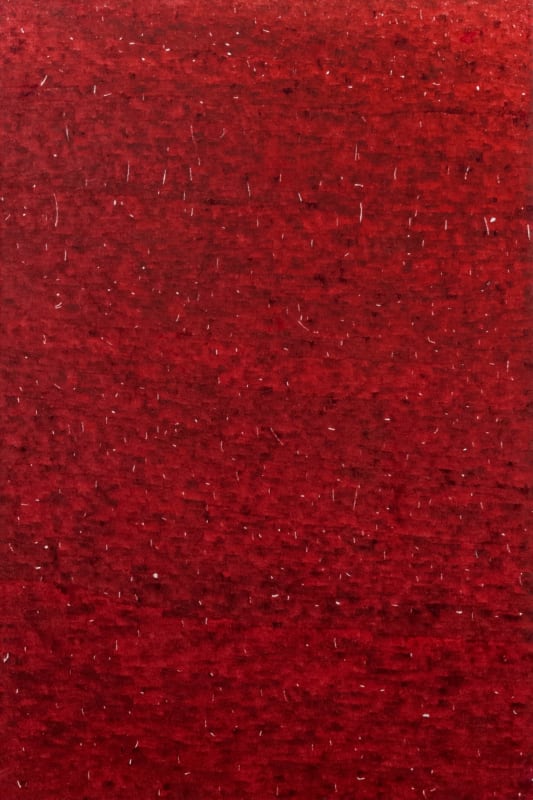This is a show defined by two vectors: one that travels from image to feeling, another from feeling to image.
Oranniwesna’s works are informed by stills from the last half-century, taken from movies, news sites, and albums he found in his late mother’s home. A strike of lighting, a now dilapidated home, an outdoor movie screen billowing in the wind: each image is connected to an intimate memory undisclosed, like letters sealed but unsent. The tunnel also becomes a recurring motif, apt for an artist long preoccupied with the themes of borders and relocation. He draws the tunnel between Chaiyaphum province and the heart of Thailand, and its sand-filled mouth after a storm. He thinks of the story his mother used to tell him of being shielded under a curved cavity when the rain came, halting a long day’s work in the fields. The sculpture Breath is the coda in this ode to childhood, home, and loss. Enigmatically biomorphic, its pistol-like elongation is rendered into a glass decanter of perfume. It evokes the shape of a femur, one blown into life through undercurrents of pain and exhaustion, recalling the deterioration of his mother’s ageing body.
This cycle of works begins with photographic certainty, but Oranniwesna bores his own passages towards obscuration. His interest in what connects periphery to centre, which was previously physical and geographical, is now one of memory, body, and material. The precision of his images, both mental and tangible, becomes blurred by graphite, glass, and paint. In these acts of transference, he distils and reduces until the images are left with their intrinsic cores of joy, nostalgia, and grief.
As if working with undeveloped negatives in a dark room, the two artists reverse visible spectrums: Korkiatarkul begins with impulse. His paintings are dances of intuition, giving vague impressions of experience and emotion without figure or form. In this body of work, painting becomes an act of surrender. He allows material to take over, the centrepiece painstakingly consumed by layer upon layer of gesso, applied until the artist’s hand had been eliminated. He yields to the environmental traces of his studio, leaving paintbrush hair and dust on canvas, turning negligible elements into testaments of time and process. He allows material to interact and transform, soaking paper in linseed oil until its fragility is assumed by the stiffness of leather. Hung from the ceiling, Far in (Blue Tide) floats in deceiving lightness, constantly shifting in opacity and colour. He also gives into the natural rhythms and restrictions of gesture, using his full wingspan to traverse his canvases or miniscule brushes to repeat the same stroke again and again. His technique varies in his metallic and coloured works, the strokes at times longitudinal and other times vertical, layered on the luminescence of gesso primer or deepened by the burnt umber of a dark wood stain.
Korkiatarkul negates the baggage that the artist is taught to bring into creation. He removes intention, forgetting attachment and possession. The works are set into motion by the sole instincts of colour and movement. As he explains, “when I started to do the white paintings, I did not know how to say something through painting. I just painted white until it became something.” He engages in an act of conjuring, and his works slowly come into form. They act as fluid planes of nuance and projection, acquiring meaning when they leave the confines of the studio. The meticulous colour fields reveal themselves: the gaps between his reiterated strokes punctuated like small sores on skin, or the uneven ripples of exposed wood grain like the swells of the tide.
This pas de deux forms an interior dark room, where we invent, hold, and expunge. In Oranniwesna’s works, we are offered deeply personal images and localities. He creates a temporal gap, waiting for the exposed negatives of social and sensorial experience to develop into the delayed pleasures and pains of remembrance. He entrusts the drawings and paintings with his memories, allowing them to transform clarity into obscure remnants of form and feeling. Yet in Korkiatarkul’s works, we begin with total abandon and are led into intuited voids. We forget baggage and context, plunging into the musicality of colour and gesture, and eventually reaching our own tangible senses and associations through ambiguous abstraction.
In Lewis Hyde’s A Primer for Forgetting, which this exhibition takes its title from, the significance of oblivion persists. Hyde suggests that forgetting creates a conscious space for new intimacies, freedoms, and associations. He recounts John Cage’s words to the painter Phillip Guston, “when you start working, everybody is in your studio—the past, your friends, enemies, the art world, and above all, your own ideas—all are there. But as you continue painting, they start leaving, one by one, and you are left completely alone. Then, if you’re lucky, even you leave.” Here, Oranniwesna and Korkiatarkul reach a departure within and from their works, inviting us to also abandon attachment and syntax, and to give into the purity of feeling.
Text by Colette Auyang
Join our mailing list
* denotes required fields
We will process the personal data you have supplied in accordance with our privacy policy (available on request). You can unsubscribe or change your preferences at any time by clicking the link in our emails.



